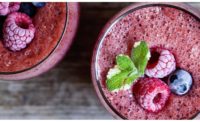2021 Predictions: PROTEIN
Protein, the King of Ingredients
Alternative protein ingredients will continue to be of interest to consumers, and food and beverage formulators

Novel plant sources, such as from highly sustainable duckweed, can fill the rapidly mounting consumer demand for vegetarian protein.
PHOTO COURTESY OF: NABIS (WWW.NABIS.COM)

Advanced technology in plant-derived stabilizers, texturizers, and proteins are helping processors craft increasingly accurate meat and dairy analogs.
PHOTO COURTESY OF: HYDROSOL GMBH & CO. (WWW.HYDROSOL.DE)


Vegetarianism and flexitarianism continue to grow in popularity, driven by health concerns as well as demand for greater sustainability and animal welfare. This means that alternative protein ingredients will continue to be of high interest to consumers, and therefore also to food and beverage formulators.
While protein and protein isolates derived from peas, soy, and other legumes remain the primary plant proteins used in snacks, baked goods, and substitutes for meat and dairy, other sources of protein have been gaining ground. In many cases, such ingredients are favored for their non-GMO or nonallergenic properties or for perceived specific health benefits.
Thus, in recent years, proteins from grains (predominantly rice and wheat, but oat protein is starting to draw attention), seeds (such as chia, quinoa, pumpkin, and hemp), nuts (almonds and peanuts mostly), and sources such as fungi, yeast, and algae have emerged and proliferated across multiple product categories. For nonvegan products, dairy proteins (usually whey but sometimes casein) and eggs remain favored for their high bioavailability.
CANOLA
The most recent — and rapidly rising — trend in protein ingredients, however, is that of deriving new items from the waste streams of other ingredient production. Canola (a specific varietal of rapeseed that’s low in erucic acid) is the second largest oilseed crop in the world, after soybeans. The press cake that remains after oil is extracted from canola is often utilized as an ingredient for animal feed.
This waste stream from canola oil production presents a good source of food-grade protein, containing 30-40% on a dry-weight basis. Canola protein has a well-balanced amino acid profile, with a high level of sulfur-containing amino acids. Canola proteins also have functional properties such as gelling, emulsifying, and foaming.
In the past decade, technological advances have been made to extract canola protein from press cake by using enzymes to target carbohydrates and fibers also contained in the cake. To boost extraction yield, manufacturers treat dehulled seeds at lower temperatures during pressing, as higher temperatures denature the proteins and decrease solubility.
Canola protein is not highly soluble at neutral pH; thus, enzymes present a method to improve recovery without the use of alkaline extraction. Protein extracted via enzymatic hydrolysis versus alkaline conditions greater solubility, according to research conducted recently in Finland.
Protein extraction methods also need to decrease antinutritional substances found in canola, such as certain phenolic compounds and phytic acid, the former of which can affect color and flavor. Also, trypsin inhibitor activity has been observed in some fractions of canola proteins; however, this can be mitigated by changing processing techniques.
Research suggests canola protein can enhance the digestibility of proteins from other sources. A recent study on the in vitro digestibility of canola and whey protein mixtures showed that one fraction of canola protein blended with b-lactoglobulin resulted in increased digestibility compared to b-lactoglobulin alone. Furthermore, canola protein is a source of bioactive peptides, with various protein fragments exhibiting antioxidant, antithrombotic, and angiotensin converting enzyme (ACE) inhibitory activity.
Canola protein is generally recognized as safe (GRAS) in the United States. Australia is evaluating approval of canola protein as a novel food ingredient. A handful of suppliers produce canola protein powder for use in food formulations.
WAIT, AVOCADOS HAVE PROTEIN?
All living things contain protein, and, as with canola, avocado oil processing leaves a press cake rich in both fiber and protein. Protein recovered from this byproduct shows promising oil absorption, water absorption, and emulsifying properties.
Researchers in China extracted protein from defatted avocado meal and showed it had greater water absorption, oil absorption, emulsion stabilization, and free radical-scavenging properties than soy protein. In vitro tests suggest bioavailability of avocado protein is lower than that of soy but slightly higher than that of protein from grains such as corn, rice, and wheat.
As with many protein sources, avocado protein could be a potential allergen. It has been implicated in food protein-induced enterocolitis syndrome in infants and toddlers. However, compared to allergies from nuts and grains, avocado allergies are relatively rare.
Several other proteins from upcycled products are in various stages of entering the pool of plant proteins available to processors. Corn protein has started to appear, and, as corn is one of the largest crops grown for food and ingredients in the world, it has a great head start. Keep an eye out for protein sourced from two popular rapeseed cousins, broccoli and mustard seed, too.
LAST CALL
Distiller’s spent grain, also known as brewer’s spent grain (BSG), is the leftover material from distilling operations and contains 15-30% protein. Like canola press cake, BSG is utilized in animal feed, especially for cattle, pigs, and in aquaculture. BSG has been shown to increase milk yield and milk fat content in dairy cattle. The protein from BSG is a good source of essential amino acids.
BSG can be used in baked goods and snacks to increase protein and fiber content, but application has been limited due to its brown color and high water content. Other suggested uses include edible films and fermented beverages. One study examined BSG flour as a replacement for wheat flour in muffins. Replacing 15% of the wheat flour with BSG increased the muffin’s protein and fiber content by 13% and 23%, respectively, with no change in consumer acceptance or product firmness.
Results from one study suggest that BSG protein is surrounded by cell wall polysaccharides secondary to increased protein solubilization that follows carbohydrase pre-treatment. Another study showed enzymatic hydrolysis can be performed without alkaline extraction to generate bioactive peptides.
BSG protein itself is not very soluble. Alkaline treatment can improve the solubilization of protein, as can hydrolysis with carbohydrases and proteases (enzymes that catalyze the breakdown of carbohydrates and proteins, respectively). This enzymatic hydrolosis also contributes to yield improvement. pf
Devon Gholam, PhD, is a food scientist with extensive background in product development and research, food product design, formulation/reformulation, sensory methodology, statistical analysis, experimental design, and analytical techniques such as HPLC, GC, and FTIR. She has worked for such companies as Roquette America, Inc.; Ganeden Biotech, Inc.; and Kellogg Co. Dr. Gholam also provides technical support, communications, presentations, white papers, and other food and ingredient marketing tools. Reach her at dld@devonlynndurkee.com.
PROTEIN FOR HEALTH
Proteins are bioactive compounds that not only provide substance and structure to tissues in addition to caloric energy, but they also are the core material of enzymes. Virtually every function in the body relies on the chemical reactions steered by enzymes. The structural components of protein — amino acids, peptides, and collagen — have enormous value to health on their own. Collagen (long fibrils of amino acids bound in a triple-helix structure) is the primary protein in the body, giving structure and foundation to all the tissues in the body, from muscles, tendons, and ligaments to bones, blood vessels, and even teeth.
Collagen as a food ingredient (usually in its hydrolyzed form, better known as “gelatin”) serves to provide structure in many products, but it also has long been used as a “beauty from within” ingredient for supporting hair and nail health. This best-known use doesn’t do the ingredient full justice, as it also has been shown to help strengthen joints and mitigate arthritis pain and speed up recovery from injuries related to sports and strenuous physical activity. Protein supports wound healing, and a 2017 study published in the journal Alimentary Pharmacology and Therapeutics suggested collagen can be of benefit to persons suffering from inflammatory digestive diseases.
Another up-and-coming plant protein source comes from duckweed (Wolffia), the world’s smallest vegetable, sometimes called water lentils. It has a history of traditional use in Asia as a versatile, natural, high-protein food. Duckweed is not only a rare plant-based source of complete, bioavailable protein, but it is rich in vitamins and minerals, especially iron and — unique in the plant world —a highly bioavailable form of vitamin B12 in significant amounts.
With a mild flavor (described as a very faint hint of fresh spinach), it is highly sustainable. When produced in a controlled environment of indoor ponds, there is minimal water consumption, minimal processing, and no contaminants.
An animal study published last March in the Journal of Nutrition indicated that duckweed can reverse symptoms of anemia, and a concurrent study demonstrated that a “green-Mediterranean diet” supplemented with duckweed “preserved iron homeostasis” in volunteers with reduced consumption of meat. Results of a study published two months later in Diabetes Care showed that, compared to controls, volunteers who ingested duckweed (in the form of a yogurt shake) experienced a lower rise in glucose with a later peak glucose time and faster glucose release from the blood. They also exhibited lower morning fasting blood glucose numbers.
Looking for a reprint of this article?
From high-res PDFs to custom plaques, order your copy today!








